KIA Sportage 2005 JE_ / 2.G Manual Online
Manufacturer: KIA, Model Year: 2005, Model line: Sportage, Model: KIA Sportage 2005 JE_ / 2.GPages: 354, PDF Size: 2.78 MB
Page 81 of 354
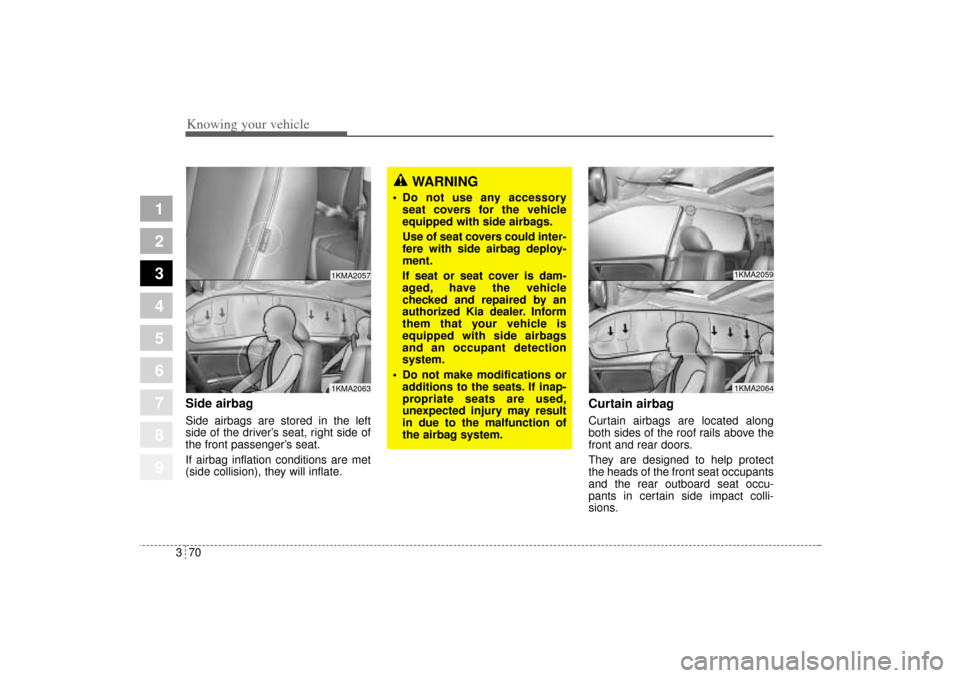
Knowing your vehicle70 3
1
2
3
4
5
6
7
8
9
Side airbagSide airbags are stored in the left
side of the driver’s seat, right side of
the front passenger’s seat.
If airbag inflation conditions are met
(side collision), they will inflate.
Curtain airbagCurtain airbags are located along
both sides of the roof rails above the
front and rear doors.
They are designed to help protect
the heads of the front seat occupants
and the rear outboard seat occu-
pants in certain side impact colli-
sions.
WARNING
Do not use any accessory
seat covers for the vehicle
equipped with side airbags.
Use of seat covers could inter-
fere with side airbag deploy-
ment.
If seat or seat cover is dam-
aged, have the vehicle
checked and repaired by an
authorized Kia dealer. Inform
them that your vehicle is
equipped with side airbags
and an occupant detection
system.
Do not make modifications or
additions to the seats. If inap-
propriate seats are used,
unexpected injury may result
in due to the malfunction of
the airbag system.
1KMA20631KMA2057
1KMA20591KMA2064
KM CAN (ENG) 3 (~112).qxd 9/13/2004 4:50 PM Page 70
Page 82 of 354
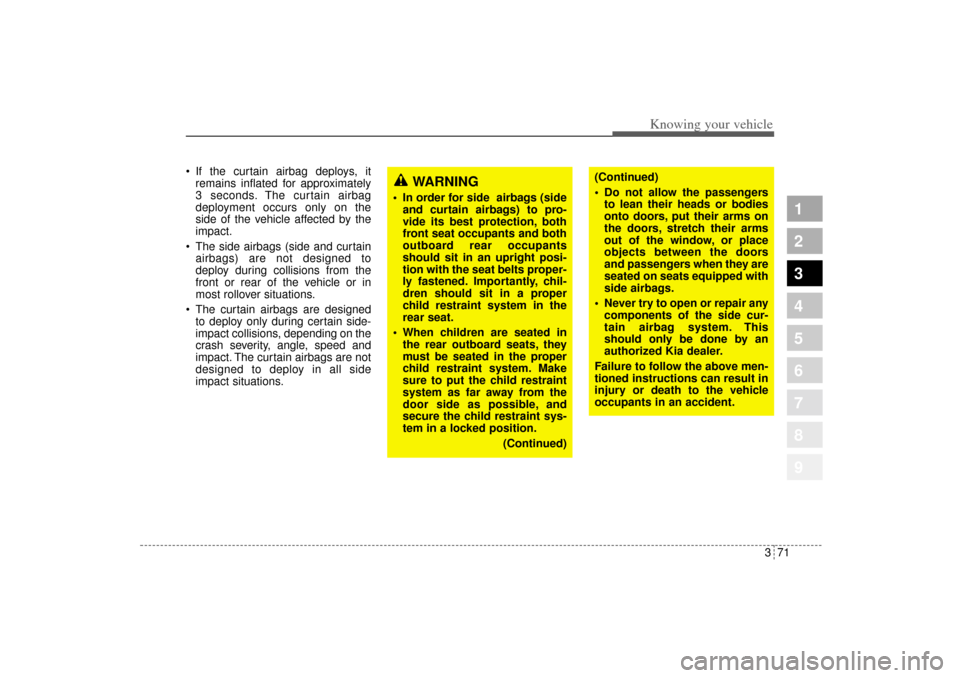
371
1
2
3
4
5
6
7
8
9
Knowing your vehicle
If the curtain airbag deploys, it
remains inflated for approximately
3 seconds. The curtain airbag
deployment occurs only on the
side of the vehicle affected by the
impact.
The side airbags (side and curtain
airbags) are not designed to
deploy during collisions from the
front or rear of the vehicle or in
most rollover situations.
The curtain airbags are designed
to deploy only during certain side-
impact collisions, depending on the
crash severity, angle, speed and
impact. The curtain airbags are not
designed to deploy in all side
impact situations.
WARNING
In order for side airbags (side
and curtain airbags) to pro-
vide its best protection, both
front seat occupants and both
outboard rear occupants
should sit in an upright posi-
tion with the seat belts proper-
ly fastened. Importantly, chil-
dren should sit in a proper
child restraint system in the
rear seat.
When children are seated in
the rear outboard seats, they
must be seated in the proper
child restraint system. Make
sure to put the child restraint
system as far away from the
door side as possible, and
secure the child restraint sys-
tem in a locked position.
(Continued)
(Continued)
Do not allow the passengers
to lean their heads or bodies
onto doors, put their arms on
the doors, stretch their arms
out of the window, or place
objects between the doors
and passengers when they are
seated on seats equipped with
side airbags.
Never try to open or repair any
components of the side cur-
tain airbag system. This
should only be done by an
authorized Kia dealer.
Failure to follow the above men-
tioned instructions can result in
injury or death to the vehicle
occupants in an accident.
KM CAN (ENG) 3 (~112).qxd 9/13/2004 4:50 PM Page 71
Page 83 of 354
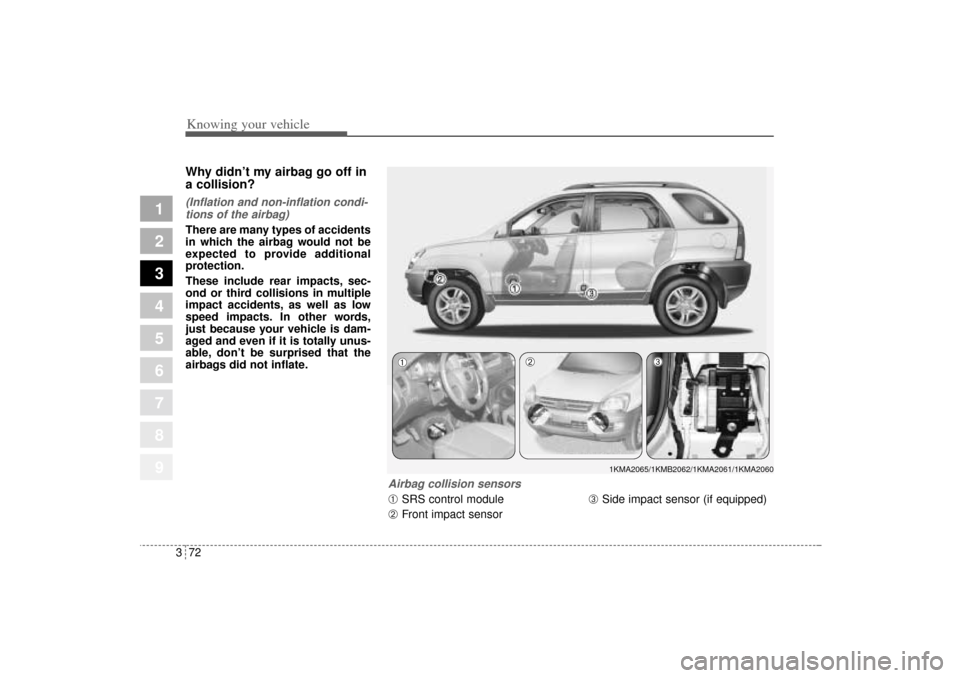
Knowing your vehicle72 3
1
2
3
4
5
6
7
8
9
Why didn’t my airbag go off in
a collision? (Inflation and non-inflation condi-
tions of the airbag)There are many types of accidents
in which the airbag would not be
expected to provide additional
protection.
These include rear impacts, sec-
ond or third collisions in multiple
impact accidents, as well as low
speed impacts. In other words,
just because your vehicle is dam-
aged and even if it is totally unus-
able, don’t be surprised that the
airbags did not inflate.
Airbag collision sensors➀
SRS control module
➁
Front impact sensor
➂
Side impact sensor (if equipped)1KMA2065/1KMB2062/1KMA2061/1KMA2060
➀
➁
➂
KM CAN (ENG) 3 (~112).qxd 9/13/2004 4:50 PM Page 72
Page 84 of 354
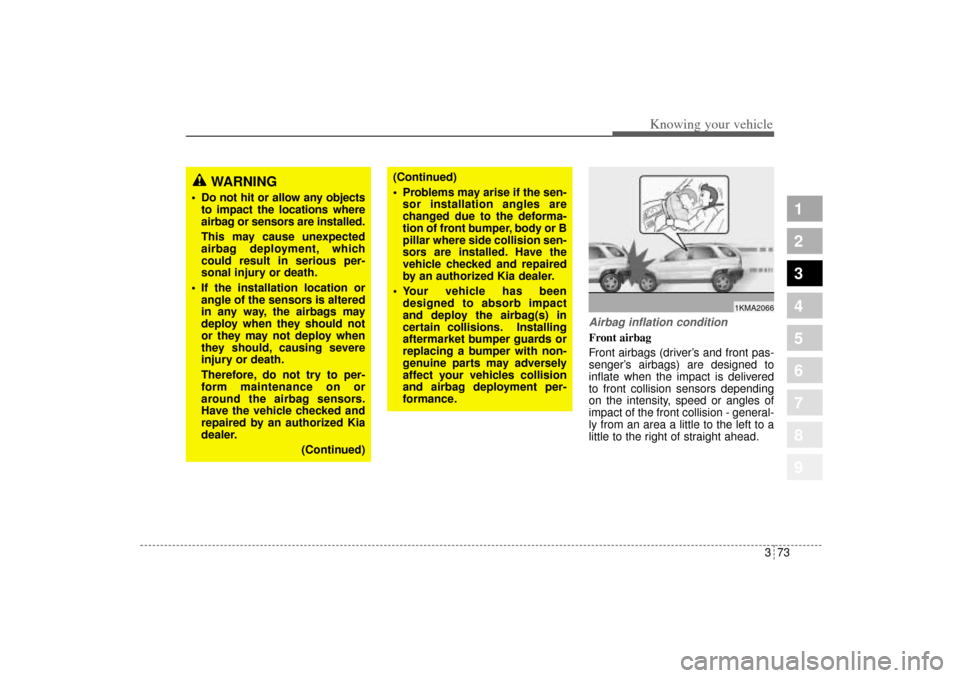
373
1
2
3
4
5
6
7
8
9
Knowing your vehicle
Airbag inflation conditionFront airbag
Front airbags (driver’s and front pas-
senger’s airbags) are designed to
inflate when the impact is delivered
to front collision sensors depending
on the intensity, speed or angles of
impact of the front collision - general-
ly from an area a little to the left to a
little to the right of straight ahead.
WARNING
Do not hit or allow any objects
to impact the locations where
airbag or sensors are installed.
This may cause unexpected
airbag deployment, which
could result in serious per-
sonal injury or death.
If the installation location or
angle of the sensors is altered
in any way, the airbags may
deploy when they should not
or they may not deploy when
they should, causing severe
injury or death.
Therefore, do not try to per-
form maintenance on or
around the airbag sensors.
Have the vehicle checked and
repaired by an authorized Kia
dealer.
(Continued)
(Continued)
Problems may arise if the sen-
sor installation angles are
changed due to the deforma-
tion of front bumper, body or B
pillar where side collision sen-
sors are installed. Have the
vehicle checked and repaired
by an authorized Kia dealer.
Your vehicle has been
designed to absorb impact
and deploy the airbag(s) in
certain collisions. Installing
aftermarket bumper guards or
replacing a bumper with non-
genuine parts may adversely
affect your vehicles collision
and airbag deployment per-
formance.
1KMA2066
KM CAN (ENG) 3 (~112).qxd 9/13/2004 4:50 PM Page 73
Page 85 of 354

Knowing your vehicle74 3
1
2
3
4
5
6
7
8
9
Side airbag (if equipped)
Side airbags (side and curtain
airbags) are designed to inflate when
the impact is delivered to side colli-
sion sensors depending on the
strength, speed or angles of impact
of side impact collision or rollover by
the side impact.Although the front airbags (driver’s
and front passenger’s airbags) are
designed to inflate only in frontal col-
lision, it may inflate in any collision if
front impact sensors are delivered
with sufficient impact.
Side airbags (side and curtain
airbags) are designed to inflate only
in side impact collision, it may inflate
in any collision if side impact sensors
are delivered with sufficient impact.In other words, they may inflate in
accidents such as slant collision or
impact, collision or impact where the
front portion of the vehicle goes
under a vehicle with a higher ground
clearance (bus or truck), collision
with a utility pole or rollover.
Therefore, drive safely at all times.
If the vehicle chassis is impacted by
bumps or objects on unimproved
roads or sidewalks, airbags may
deploy. Drive carefully on unim-
proved roads or on surfaces not
designed for vehicle traffic.
To protect occupants, front airbags
or pre-tensioner seat belts may
deploy in certain side impact colli-
sions.
1KMN20671KMB2064
KM CAN (ENG) 3 (~112).qxd 9/13/2004 4:50 PM Page 74
Page 86 of 354
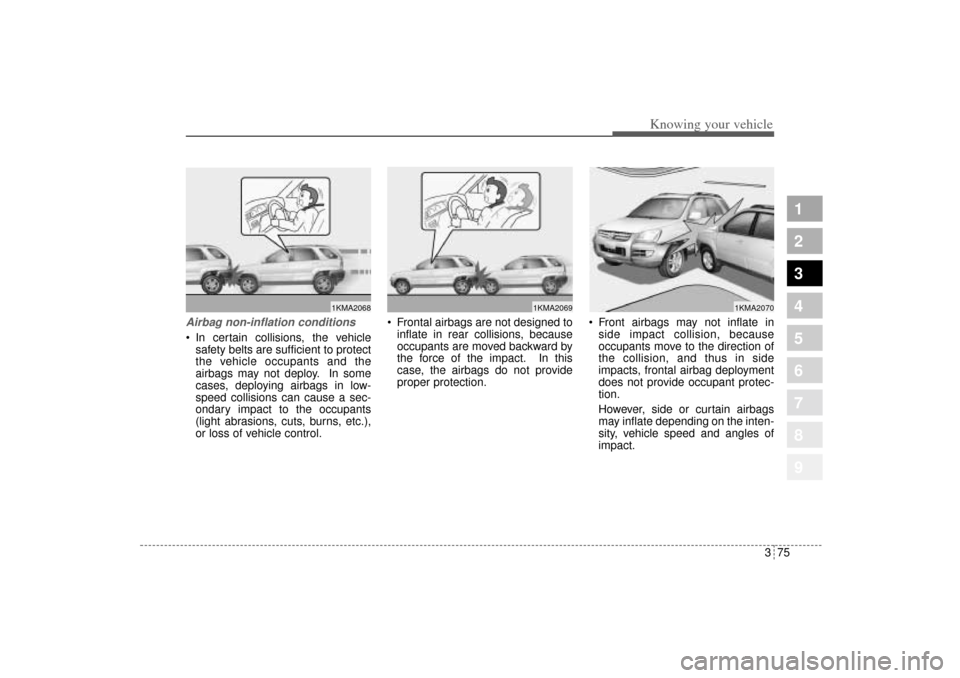
375
1
2
3
4
5
6
7
8
9
Knowing your vehicle
Airbag non-inflation conditions In certain collisions, the vehicle
safety belts are sufficient to protect
the vehicle occupants and the
airbags may not deploy. In some
cases, deploying airbags in low-
speed collisions can cause a sec-
ondary impact to the occupants
(light abrasions, cuts, burns, etc.),
or loss of vehicle control. Frontal airbags are not designed to
inflate in rear collisions, because
occupants are moved backward by
the force of the impact. In this
case, the airbags do not provide
proper protection. Front airbags may not inflate in
side impact collision, because
occupants move to the direction of
the collision, and thus in side
impacts, frontal airbag deployment
does not provide occupant protec-
tion.
However, side or curtain airbags
may inflate depending on the inten-
sity, vehicle speed and angles of
impact.
1KMA2069
1KMA2068
1KMA2070
KM CAN (ENG) 3 (~112).qxd 9/13/2004 4:50 PM Page 75
Page 87 of 354
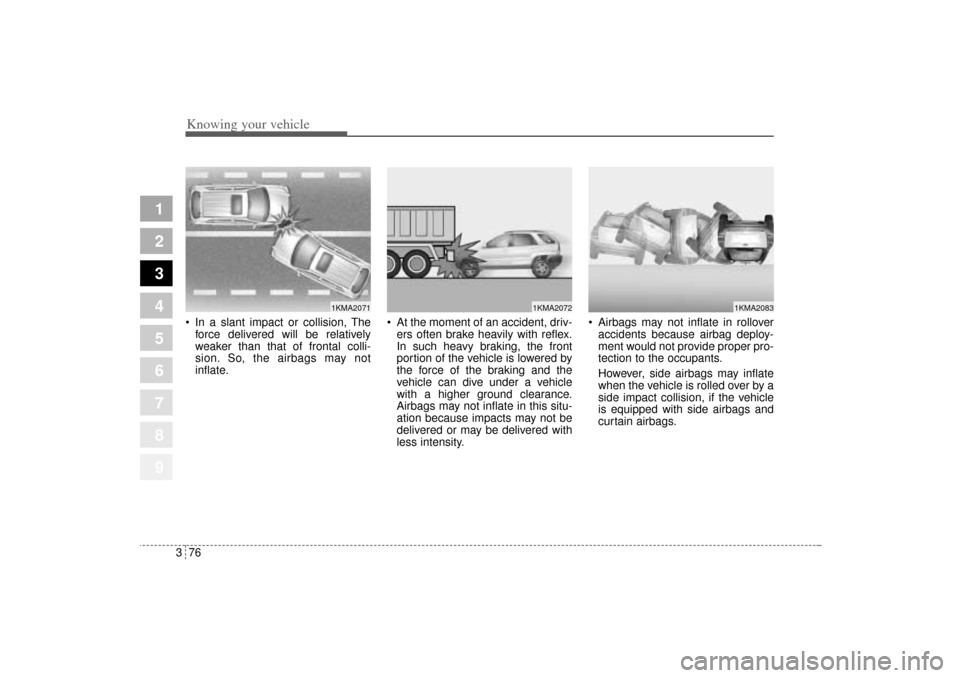
Knowing your vehicle76 3
1
2
3
4
5
6
7
8
9
In a slant impact or collision, The
force delivered will be relatively
weaker than that of frontal colli-
sion. So, the airbags may not
inflate. At the moment of an accident, driv-
ers often brake heavily with reflex.
In such heavy braking, the front
portion of the vehicle is lowered by
the force of the braking and the
vehicle can dive under a vehicle
with a higher ground clearance.
Airbags may not inflate in this situ-
ation because impacts may not be
delivered or may be delivered with
less intensity. Airbags may not inflate in rollover
accidents because airbag deploy-
ment would not provide proper pro-
tection to the occupants.
However, side airbags may inflate
when the vehicle is rolled over by a
side impact collision, if the vehicle
is equipped with side airbags and
curtain airbags.
1KMA2071
1KMA2072
1KMA2083
KM CAN (ENG) 3 (~112).qxd 9/13/2004 4:50 PM Page 76
Page 88 of 354
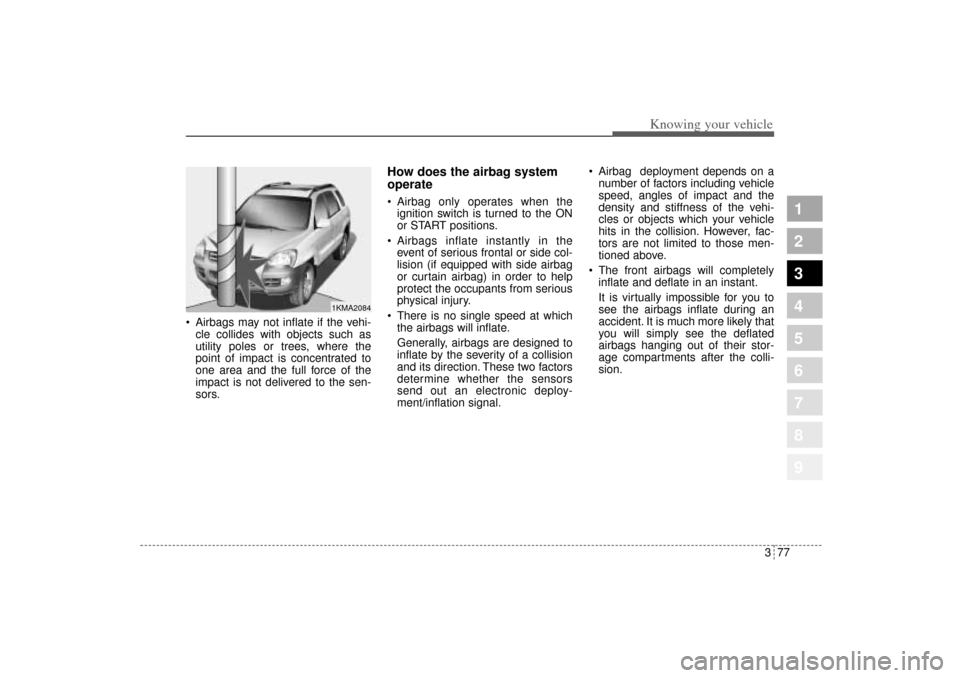
377
1
2
3
4
5
6
7
8
9
Knowing your vehicle
Airbags may not inflate if the vehi-
cle collides with objects such as
utility poles or trees, where the
point of impact is concentrated to
one area and the full force of the
impact is not delivered to the sen-
sors.
How does the airbag system
operate Airbag only operates when the
ignition switch is turned to the ON
or START positions.
Airbags inflate instantly in the
event of serious frontal or side col-
lision (if equipped with side airbag
or curtain airbag) in order to help
protect the occupants from serious
physical injury.
There is no single speed at which
the airbags will inflate.
Generally, airbags are designed to
inflate by the severity of a collision
and its direction. These two factors
determine whether the sensors
send out an electronic deploy-
ment/inflation signal. Airbag deployment depends on a
number of factors including vehicle
speed, angles of impact and the
density and stiffness of the vehi-
cles or objects which your vehicle
hits in the collision. However, fac-
tors are not limited to those men-
tioned above.
The front airbags will completely
inflate and deflate in an instant.
It is virtually impossible for you to
see the airbags inflate during an
accident. It is much more likely that
you will simply see the deflated
airbags hanging out of their stor-
age compartments after the colli-
sion.
1KMA2084
KM CAN (ENG) 3 (~112).qxd 9/13/2004 4:50 PM Page 77
Page 89 of 354
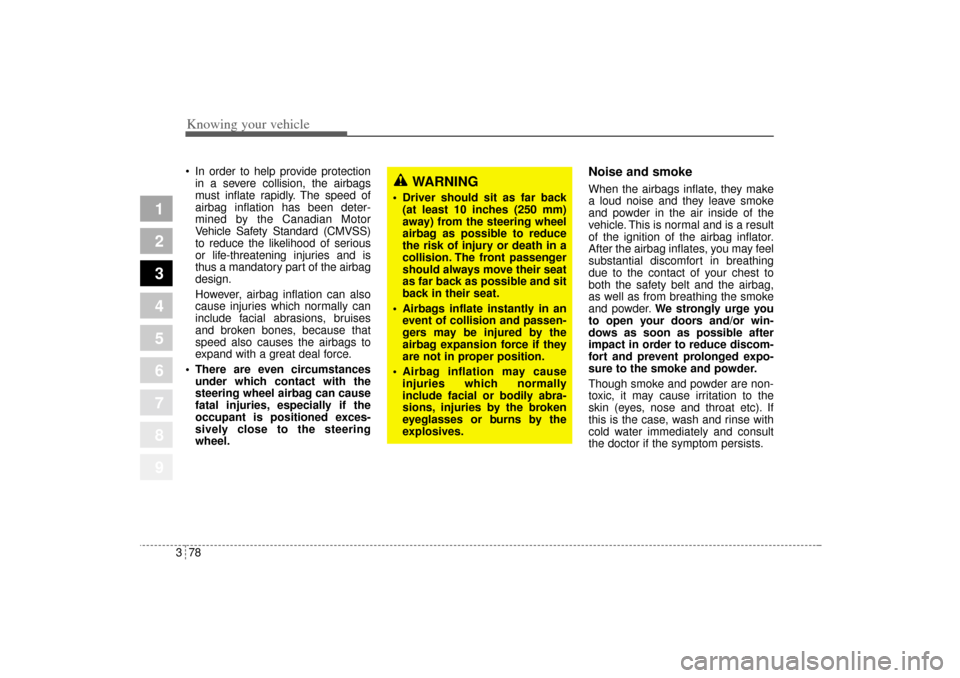
Knowing your vehicle78 3
1
2
3
4
5
6
7
8
9
In order to help provide protection
in a severe collision, the airbags
must inflate rapidly. The speed of
airbag inflation has been deter-
mined by the Canadian Motor
Vehicle Safety Standard (CMVSS)
to reduce the likelihood of serious
or life-threatening injuries and is
thus a mandatory part of the airbag
design.
However, airbag inflation can also
cause injuries which normally can
include facial abrasions, bruises
and broken bones, because that
speed also causes the airbags to
expand with a great deal force.
There are even circumstances
under which contact with the
steering wheel airbag can cause
fatal injuries, especially if the
occupant is positioned exces-
sively close to the steering
wheel.
Noise and smokeWhen the airbags inflate, they make
a loud noise and they leave smoke
and powder in the air inside of the
vehicle. This is normal and is a result
of the ignition of the airbag inflator.
After the airbag inflates, you may feel
substantial discomfort in breathing
due to the contact of your chest to
both the safety belt and the airbag,
as well as from breathing the smoke
and powder.We strongly urge you
to open your doors and/or win-
dows as soon as possible after
impact in order to reduce discom-
fort and prevent prolonged expo-
sure to the smoke and powder.
Though smoke and powder are non-
toxic, it may cause irritation to the
skin (eyes, nose and throat etc). If
this is the case, wash and rinse with
cold water immediately and consult
the doctor if the symptom persists.
WARNING
Driver should sit as far back
(at least 10 inches (250 mm)
away) from the steering wheel
airbag as possible to reduce
the risk of injury or death in a
collision. The front passenger
should always move their seat
as far back as possible and sit
back in their seat.
Airbags inflate instantly in an
event of collision and passen-
gers may be injured by the
airbag expansion force if they
are not in proper position.
Airbag inflation may cause
injuries which normally
include facial or bodily abra-
sions, injuries by the broken
eyeglasses or burns by the
explosives.
KM CAN (ENG) 3 (~112).qxd 9/13/2004 4:50 PM Page 78
Page 90 of 354
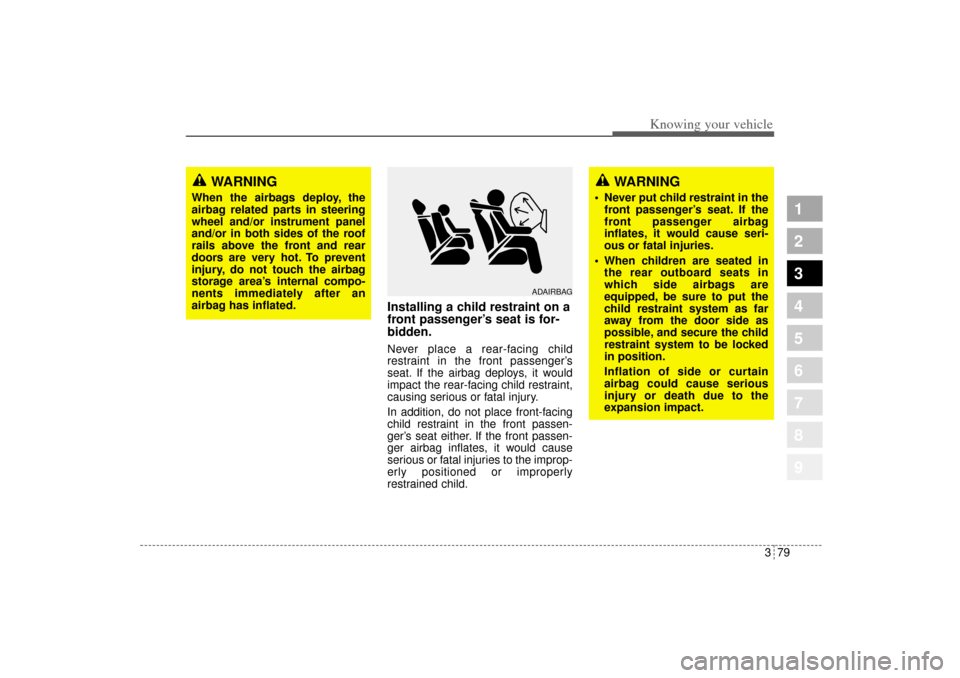
379
1
2
3
4
5
6
7
8
9
Knowing your vehicle
Installing a child restraint on a
front passenger’s seat is for-
bidden.Never place a rear-facing child
restraint in the front passenger’s
seat. If the airbag deploys, it would
impact the rear-facing child restraint,
causing serious or fatal injury.
In addition, do not place front-facing
child restraint in the front passen-
ger’s seat either. If the front passen-
ger airbag inflates, it would cause
serious or fatal injuries to the improp-
erly positioned or improperly
restrained child.
WARNING
Never put child restraint in the
front passenger’s seat. If the
front passenger airbag
inflates, it would cause seri-
ous or fatal injuries.
When children are seated in
the rear outboard seats in
which side airbags are
equipped, be sure to put the
child restraint system as far
away from the door side as
possible, and secure the child
restraint system to be locked
in position.
Inflation of side or curtain
airbag could cause serious
injury or death due to the
expansion impact.
WARNING
When the airbags deploy, the
airbag related parts in steering
wheel and/or instrument panel
and/or in both sides of the roof
rails above the front and rear
doors are very hot. To prevent
injury, do not touch the airbag
storage area’s internal compo-
nents immediately after an
airbag has inflated.
ADAIRBAG
KM CAN (ENG) 3 (~112).qxd 9/13/2004 4:50 PM Page 79